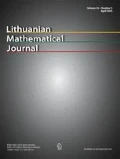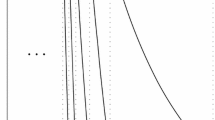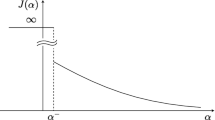Abstract
We establish a central limit theorem for counting large continued fraction digits (an), that is, we count occurrences {an>bn}, where (bn) is a sequence of positive integers. Our result improves a similar result by Philipp, which additionally assumes that bn tends to infinity. Moreover, we give a refinement of the famous Borel–Bernstein theorem for continued fractions regarding the event that the nth continued fraction digit lies infinitely often between dn and dn(1 + 1/cn) for given sequences (cn) and (dn). Also, for these sets, we obtain a central limit theorem. As an interesting side result, we explicitly determine the first φ-mixing coefficient for the Gauss system.
Similar content being viewed by others
References
F. Bernstein, Über eine Anwendung der Mengenlehre auf ein aus der Theorie der säkularen Störungen herrührendes Problem, Math. Ann., 71(3):417–439, 1911, available from https://doi.org/10.1007/BF01456856.
F. Bernstein, Über geometrische Wahrscheinlichkeit und über das Axiom der beschränkten Arithmetisierbarkeit der Beobachtungen, Math. Ann., 72(4):585–587, 1912, available from https://doi.org/10.1007/BF01456678.
E. Borel, Les probabilités denombrables et leurs applications arithmétiques, Rend. Circ. Mat. Palermo, 27:247–271, 1909, available from https://doi.org/10.1007/BF03019651.
J. Borwein, A. van der Poorten, J. Shallit, and W. Zudilin, Neverending fractions: An Introduction to Continued Fractions, Aust. Math. Soc. Lect. Ser., Vol. 23, Cambridge Univ. Press, Cambridge, 2014, available from https://doi.org/10.1017/CBO9780511902659.
R.C. Bradley, Basic properties of strong mixing conditions. A survey and some open questions, Probab. Surv., 2:107–144, 2005, available from https://doi.org/10.1214/154957805100000104.
K. Dajani and C. Kraaikamp, Ergodic Theory of Numbers, The Mathematical Association of America, Washington, July 2002.
A.-H. Fan, L.-M. Liao, B.-W. Wang, and J. Wu, On Khintchine exponents and Lyapunov exponents of continued fractions, Ergodic Theory Dyn. Syst., 29(1):73–109, 2009, available from https://doi.org/10.1017/S0143385708000138.
K. Ford, The distribution of integers with a divisor in a given interval, Ann. Math. (2), 168(2):367–433, 2008, available from https://doi.org/10.4007/annals.2008.168.367.
J. Galambos, Some remarks on the Lüroth expansion, Czech. Math. J., 22(2):266–271, 1972.
M. Iosifescu and C. Kraaikamp, Metrical Theory of Continued Fractions, Math. Appl., Dordr., Springer, Dordrecht, December 2002.
O. Jenkinson and M. Pollicott, Rigorous effective bounds on the Hausdorff dimension of continued fraction Cantor sets: A hundred decimal digits for the dimension of E2, Adv. Math., 325:87–115, 2018, available from https://doi.org/10.1016/j.aim.2017.11.028.
M. Kesseböhmer, S. Munday, and B. O. Stratmann, Infinite Ergodic Theory of Numbers, De Gruyter Textb., De Gruyter, Berlin, 2016, available from https://doi.org/10.1515/9783110439427.
M. Kesseböhmer and B.O. Stratmann, A multifractal analysis for Stern–Brocot intervals, continued fractions and Diophantine growth rates, J. Reine Angew. Math., 605:133–163, 2007, available from https://doi.org/10.1515/CRELLE.2007.029.
M. Kesseböhmer and S. Zhu, Dimension sets for infinite IFSs: the Texan conjecture, J. Number Theory, 116(1):230–246, 2006, available from https://doi.org/10.1016/j.jnt.2005.04.002.
A.Ya. Khinchin, Continued Fractions, University of Chicago Press, Chicago, 1964.
A.Y. Khintchine, Metrische Kettenbruchprobleme, Compos. Math., 1:361–382, 1935.
L. Liao and M. Rams, Upper and lower fast Khintchine spectra in continued fractions, Monatsh.Math., 180(1):65–81, 2016, available from https://doi.org/10.1007/s00605-016-0879-z.
W. Philipp, Some metrical theorems in number theory, Pac. J. Math., 20(1):109–127, 1967, available from https://doi.org/10.2140/pjm.1967.20.109.
W. Philipp, Some metrical theorems in number theory. II, Duke Math. J., 37:447–458, 1970, available from https://doi.org/10.1215/S0012-7094-70-03756-7.
W. Philipp, Limit theorems for sums of partial quotients of continued fractions, Monatsh. Math., 105(3):195–206, 1988, available from https://doi.org/10.1007/BF01636928.
W. Philipp and G.R.Webb, An invariance principle for mixing sequences of random variables, Z.Wahrscheinlichkeitstheor. Verw. Geb., 25:223–237, 1973, available from https://doi.org/10.1007/BF00535894.
J.D. Samur, A note on the convergence to Gaussian laws of sums of stationary φ-mixing triangular arrays, in Probability in Banach spaces V (Medford, MA, USA 1984), Lect. Notes Math., Vol. 1153, Springer, Berlin, 1985, pp. 387–399, available from: https://doi.org/10.1007/BFb0074962.
B.-W. Wang and J. Wu, Hausdorff dimension of certain sets arising in continued fraction expansions, Adv. Math., 218(5):1319–1339, 2008, available from https://doi.org/10.1016/j.aim.2008.03.006.
T.M. Zuparov, On a theorem from the metric theory of continued fractions, in Thirteen Papers in Algebra, I.G. Dmitriev et al. (Eds.), Transl., Ser. 2, Am. Math. Soc., Vol. 132, AMS, Providence, RI, 1986, pp. 41–44, available from: https://doi.org/10.1090/trans2/132.
Author information
Authors and Affiliations
Corresponding author
Additional information
Publisher’s note
Springer Nature remains neutral with regard to jurisdictional claims in published maps and institutional affiliations.
This research was supported by the German Research Foundation (DFG) grant “Renewal Theory and Statistics of Rare Events in Infinite Ergodic Theory” (Geschäftszeichen KE 1440/2-1). The research of TS was conducted at University of Bremen and at the Australian National University. While at University of Bremen TS was supported by the Studienstiftung des Deutschen Volkes.
Rights and permissions
About this article
Cite this article
Kesseböhmer, M., Schindler, T.I. Limit theorems for counting large continued fraction digits. Lith Math J 60, 189–207 (2020). https://doi.org/10.1007/s10986-020-09479-5
Received:
Revised:
Published:
Issue Date:
DOI: https://doi.org/10.1007/s10986-020-09479-5




